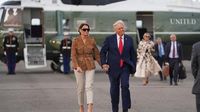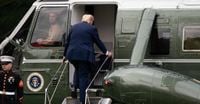On the evening of September 20, 2025, a seemingly routine patrol near the White House took a dangerous turn when Jacob Samuel Winkler, a 33-year-old Washington, D.C. resident, aimed a red laser pointer at Marine One as it lifted off with President Donald Trump aboard. The incident, which unfolded just after 7:30 p.m. along Constitution Avenue, has since sparked renewed concern about the growing threat of laser strikes on aircraft, especially those carrying high-profile passengers.
According to a criminal complaint cited by The Hill, Secret Service Officer Diego Santiago was conducting routine patrols in preparation for Marine One’s departure from the White House. Santiago observed Winkler, shirtless and loudly talking to himself on the sidewalk near the Ellipse, a park just south of the White House. Due to the low light on the sidewalk, Santiago shined his flashlight toward Winkler for further observation—a move that prompted an unexpected and dangerous response.
As Santiago described in his affidavit, Winkler retaliated by shining a red laser beam directly into the officer’s face, briefly disorienting him. The situation escalated when, moments later, Winkler looked up and pointed the same laser beam at Marine One, which was flying low as it began its ascent toward the Washington Monument. President Trump was en route to Mount Vernon, Virginia, to deliver a speech to the American Cornerstone Institute, as reported by The New York Times.
Officer Santiago’s account, detailed in court documents and echoed by multiple outlets including Fox News Digital and the Associated Press, underscores the immediate risk: “This behavior posed a risk of flash blindness and pilot disorientation, especially during low-level flight near other helicopters (U.S. Park Police, U.S. Marine Corps) and the Washington Monument. This placed Marine One at risk of an airborne collision.”
The Secret Service moved swiftly. After shining the laser at both the officer and the presidential helicopter, Winkler was detained, the pointer was removed from his hand, and he was handcuffed. According to the criminal complaint, Winkler then knelt on the ground and repeatedly said phrases like, “I should apologize to Donald Trump,” and “I apologize to Donald Trump.” Investigators also found a fixed-blade knife, approximately three inches long, in Winkler’s possession.
During a subsequent interview, Winkler admitted to shining the laser at Marine One. He reportedly told investigators he was unaware that it was illegal to do so, stating, “He said he points the laser at all kinds of things, such as stop signs,” as noted in the complaint. Winkler’s apparent lack of awareness did little to diminish the seriousness of the offense in the eyes of federal authorities.
Winkler has been charged with aiming a laser pointer at an aircraft, a federal felony punishable by up to five years in prison and a fine of up to $250,000. The Federal Aviation Administration (FAA) can also levy additional fines up to $32,000 for such offenses. As of Monday, online court records did not indicate whether Winkler had legal representation, a detail confirmed by the Associated Press and The New York Times.
Jeanine Pirro, the U.S. Attorney for Washington, D.C., issued a stern warning in a statement to the Associated Press: “This behavior endangers Marine One and everyone on board. If you engage in this act, you will be identified and prosecuted to the fullest extent of the law.”
While the court filings do not specify whether anyone aboard Marine One noticed the laser, the risks are well-documented. According to the FAA, laser strikes can cause flash blindness, disorientation, and even incapacitate pilots—particularly dangerous during low-altitude maneuvers or in crowded airspace. The agency has recorded 5,913 laser incidents across the United States so far in 2025, averaging about 28 per day, with six of those incidents resulting in injuries. Last year, the total number of reported laser strikes was 12,840, highlighting a persistent and growing safety concern.
The criminal complaint, filed in the D.C. District Court and signed by Magistrate Judge Zia Faruqui, lays out a clear sequence of events. Winkler was first observed by Officer Santiago as he “shirtless, talking to himself and being loud” on Constitution Avenue. After the officer’s flashlight beam prompted a retaliatory laser strike, Winkler then aimed the device at Marine One as it flew overhead, carrying the president and his entourage to a private dinner in Virginia. The complaint notes that the action “posed a risk of flash blindness and pilot disorientation, especially during low-level flight near other helicopters and the Washington Monument.”
Following the arrest, Winkler’s statements to law enforcement were both contrite and revealing. He repeatedly expressed a desire to apologize to President Trump, according to multiple outlets, and admitted to pointing the laser at Marine One as well as other objects in the past. This admission, while perhaps intended to minimize intent, underscores a broader issue: the widespread availability of high-powered laser pointers and the lack of public awareness about the dangers—and illegality—of aiming them at aircraft.
Federal authorities have increasingly cracked down on so-called “laser strikes” in recent years. The FAA, for its part, has launched public awareness campaigns and increased penalties, but the problem persists. Pilots report that even brief exposure to a laser beam can cause temporary blindness, distraction, and in some cases, permanent eye injury. Given the proximity of other helicopters and the complex airspace around Washington, D.C., the risks in this case were particularly acute.
As for Marine One, the presidential helicopter is operated by a highly trained crew and is accompanied by other aircraft during flights in and out of the capital. The Secret Service, along with the U.S. Marine Corps and U.S. Park Police, maintains strict protocols to protect the president and mitigate airborne threats. In this incident, officials confirmed there was no impact to protective operations, but the episode serves as a stark reminder of the vulnerabilities that remain.
The White House did not immediately comment on the incident, and a federal public defender representing Winkler had not responded to requests for comment by press time. The FAA referred questions to the Secret Service, which has not provided additional details beyond the initial statements.
For now, Winkler faces the prospect of significant prison time and steep fines. The case has reignited debate in aviation and security circles about how best to deter similar incidents, especially as laser devices remain cheap, accessible, and powerful. As the number of reported laser strikes continues to climb, federal authorities are sending a clear message: such acts will not be tolerated, particularly when the nation’s highest office is at risk.
With the investigation ongoing and the legal process just beginning, the incident stands as a potent example of how a moment of recklessness can have far-reaching consequences in an era of heightened security and vigilance.

